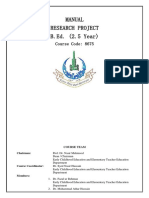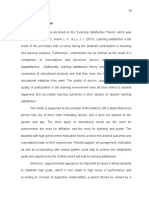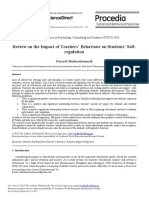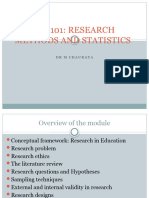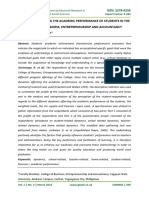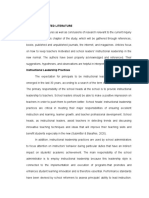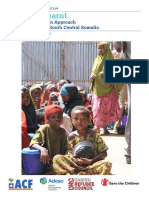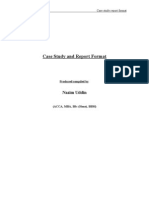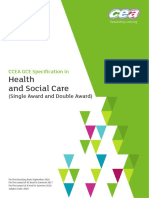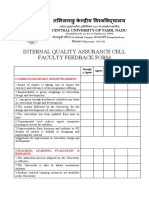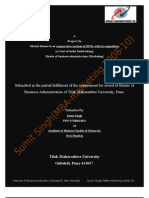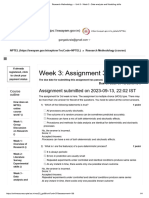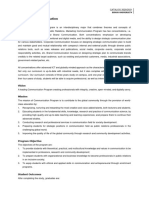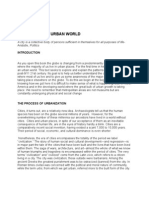CHAPTER THREE
RESEARCH METHODOLOGY
3.1 Introduction
The chapter presents research design, the population of the study, the source of data and
sampling methods, sample size, techniques and procedures to be used. It also indicates the
data collection procedures, methods and tools that were used, expected outcome and how the
researcher deals with ethical issues that will be encountered.
3.2 Research design
In the study, a cross-sectional research design will be adopted. In this design data on all the
variables in the study context will be collected at one point in time. Despite the fact that this
design basically gives a snap short, it is widely accepted in earlier studies addressing similar
issues.
Furthermore, the study will be descriptive in establishing the teacher motivation and learners’
performance. Beyond that the study explained the links between the practices that are to be
investigated. The study utilized quantitative approach as the interest in generalizing the
evidence collected.
3.3 Population of the study
The study will be done at Little Harvard junior school, Kigoma Wakiso that represented the
entire pre primary schools in the study context. The focus on Little Harvard junior school will
be to obtain a general picture regarding the issues under study. The database will be
developed by visiting offices and soliciting for the participation of teachers and
administrators
3.4 Sample size and sampling procedure
The sample of the study will be 35 respondents who will be served the questionnaires. These
will constitute Teachers, School administrators, CDO and Selected parents. The study will
utilize purposive sampling in which the selection of study respondents will be done basing on
the number of respondents of interest in the selected category. The sample size will be
determined using the Krejcie and morgan formula 1970 of determining sample size. A total of
35 questionnaires will be hand delivered and filled in a face-to-face interaction with the
respondent.
1
� Category Population Sample size Sampling procedure
Teachers 10 10 Purposive sampling
School administrators 6 5 Simple random
sampling
CDO 1 1 Purposive sampling
Selected parents 20 19 Simple random
sampling
37 35
Source: Research data, 2024
3.5 Data collection method
Questionnaire method will be utilized to administer a survey instrument. This is where
questionnaires will be drafted which will include questions on teacher motivation and their
implications in the study context. The questionnaires will be delivered to various staff and
administrators in the study context. This will be done following the recommendations by
various scholars that include Kothari (2004); Sekaran and Bougie (2010). In some sections of
the instruments; there will be questions that had predetermined answers. Other questions will
be open ended. A mixture of these questions will be encouraged to avoid artifacts in
respondent’s answers.
3.6 Procedures of data collection
The researcher acquired approval from the Luigi Giussani Institute of Higher Education in the
faculty of education through the institute research supervisor to ensure that the ethical
guidelines are followed throughout the data collection process.
3.7 Reliability and validity of the study
To ensure the quality of the research process, all the items included in the study will be based
on earlier studies and thoroughly reviewed by the supervisor before the data collection. In
addition, a number of tests will be conducted on reliability and validity of the data.
In the context of validity, factor analysis will be utilized. The factor loadings for the items
included in the study have thresholds and which statistically means that, there will be a
reasonable level of validity or not, of the items included in tapping into the variables of
interest (Sekaran & Bougie, 2010). In addition, all the items that utilized will be reviewed as
2
�based on earlier studies to ensure that no guess work is involved in conceptualizing the
variables and or tap in their accepted meanings and operationalization.
3.8 Data analysis
After data collection, the researcher will cross examine the questionnaires to ascertain
completeness and accuracy of information obtained. Both qualitative and quantitative data
will be collected and coded by assigning numerals to answers and responses are put into
limited number of categories. Data will then be arranged logically by tabulation. Frequency
distribution tables will be used to represent the information from all respondents for each
item of the questionnaire.
Qualitative data will be analyzed using content analysis based on information on academic
performance statistics. Qualitative data will be presented thematically in line with study
objectives and research questions. Thematic representation will involve analyzing the
findings according to the subject matter using the given objectives.
Quantitative data will be analyzed using Microsoft Excel and the results presented using
frequency tables, percentages to make meaningful conclusions. This is deemed to be easy in
interpretation and is convenient in giving general overview of the subject under study.
3.9 Limitation of the Study
(i) Financial constraint since research requires money for printing and transport.
This may occur when the actual expenditure exceeded the budget. The
predetermined budget will be adjusted and the researcher managed to get extra
funds to complete the data correction exercise.
(ii) Some of the respondents may not be friendly and co-operative thus reluctant to
fill in the questionnaires in time. But the research adopted a interview guide which
helped to scoop other relevant information to supplement the questionnaire.
(iii) There might be too much pressure as however, the researcher devoted
most of the time on the research the researcher requested for a leave to finalize the
research process.
3
� REFERENCES
Ahmed, M., Samee, F., & Khalid, S. (2021). Head Teachers’ Instructional Supervisory
Practices and Teachers’ Motivation in Teaching. PJE.
Ferda Bedel, E. (2015). Exploring Academic Motivation, Academic Self-efficacy and
Attitudes toward Teaching in Pre-service Early Childhood Education Teachers.
Ferda Bedel, E. (2015). Exploring Academic Motivation, Academic Self-efficacy and
Attitudes toward Teaching in Pre-service Early Childhood Education Teachers. [PDF]
Kagema, J. (2018). The School Curriculum and Its Influence on Teacher Motivation in
Curriculum Implementation in Kenya. [PDF]
Kunter, M., Klusmann, U., Baumert, J., Richter, D., Voss, T., & Hachfeld, A. (2013).
Professional competence of teachers: Effects on instructional quality and student
development. Journal of Educational Psychology, 105(3), 805–820.
Ladd Berhenke, A. (2013). Motivation, Self-Regulation, and Learning in Preschool.
Meng, Y. (2021). Fostering EFL/ESL Students' State Motivation: The Role of Teacher-
Student Rapport.
Patrick, S. (2016). Exploring Direct and Indirect Relationships among Teacher Self-efficacy,
Motivations for Teaching, Teacher-child Interactions, and Child Outcomes in Early
Head Start Classrooms.
Rahabav, P. (2016). The Effectiveness of Academic Supervision for Teachers. Journal of
Education and Practice, 7, 47-55.
Viseu, J., Jesus, S., Rus, C., Manuel Canavarro, J., & Pereira, J. (2016). La Relación Entre la
Motivación Docente y Variables de la Organización: Revisión de la Literatura.
Viseu, J., Jesus, S., Rus, C., Manuel Canavarro, J., & Pereira, J. (2016). La Relación Entre la
Motivación Docente y Variables de la Organización: Revisión de la Literatura.
4
�Wang, Y., Jiang, G., Yao, Z., & Liu, L. (2024). The influence of teacher–student relationship
on Chinese high school students' academic motivation for the ideological and political
subject: the mediating role of academic emotions. ncbi.nlm.nih.gov
Werang, B. R., Agung, A. A., Jampel, N., Gading, K., Jim, E. L., Asaloei, S. I., & Sianturi, M.
(2024). Exploring the simultaneous impact of parental support, school environment,
teacher morale, and student learning motivation on student academic performance.
International Journal of Religion, 5(2), 510-520.
World English Journal, A. & BOURAS, H. (2019). Enhancing Students’ Effectiveness
through Motivational Strategies.
World English Journal, A. & Sulaiman Faye Asiri, M. (2023). Potential Benefits of
Enhancing Motivation on English Language Learners’ Performance.
World English Journal, A. & Sulaiman Faye Asiri, M. (2023). Potential Benefits of
Enhancing Motivation on English Language Learners’ Performance. osf.io
Yeager, K. (2008). Motivating Students: Identifying and Motivating Reluctant Learners to
Reach Their Academic Potential.
Zhu, D. (2022). English as a Foreign Language Teachers’ Identity and Motivation: The Role
of Mindfulness.
5
� APPENDICES
Appendix 1: Questionnaire
Dear respondent,
I am
NAMUDDU FLORENCE, a student of Luigi Giussani Institute of Higher Education.
As part of the academic requirements for the award of a Diploma in Early childhood
education, students are required to conduct field research and present their findings. I am
therefore conducting research entitled, “Impact of teacher motivation and academic
performance of learners in Early childhood education centers.” The importance of this
letter is to kindly request you to provide information regarding the study. All your views will
be kept confidential and every part of your response will be used only for academic purposes.
Section 1: Demographic Information
This questionnaire aims to gather information on the impact of teacher motivation and
academic performance of learners in early childhood education centers.
1. Marital status:
[ ] Single [ ] Married
2. Age: … … … … … ….
3. Gender:
[ ] Male [ ] Female
4. Level of Education:
[ ] Primary [ ] Secondary [ ] College [ ] University
6
�SECTION B: (Please indicate your level of agreement with the following
statements using the scale provided)
1 = Strongly Disagree
2 = Disagree
3 = Neutral
4 = Agree
5 = Strongly Agree
5. With reference to your knowledge, what is the relationship between teacher
motivation and learners’ engagement?
Relationship between teacher motivation and 1 2 3 4
learners’ engagement.
A motivated and engaged teacher can lead to improved
learning outcomes for students.
Teachers' motivations can also influence their students'
motivations, and teachers who are motivated can
effectively instill a love for learning in their students.
Teachers who can provide students with an
understanding of the material, and make the learning
experience fun, can result in students being more likely
to pay attention, and try to understand the material,
instead of simply going through the motions
Teachers who are passionate about their subject matter
and feel confident in their teaching abilities are more
likely to create engaging and motivating learning
environments for their students.
Motivated teachers create a positive and engaging
learning atmosphere thus harnessing student
engagement
7
�6. With reference to your knowledge, what is the impact of teacher motivation on
learner academic achievement?
Impact of teacher motivation on learner academic 1 2 3 4
achievement.
The amount of salary paid to ECE teachers positively
influences provision of quality ECD education
Continuous promotion of ECE teachers positively
influences provision of quality ECE education
Giving advance payment from the school in case one has
a financial problem helps teachers settle thus giving
learners the attention they need.
Motivated teachers tend to establish stronger and more
supportive relationships with their students
Motivated teachers are more likely to adopt innovative
and effective teaching strategies that cater to students'
diverse learning styles.
8
�7. With reference to your knowledge, what are the strategies for enhancing teacher
motivation and improving learner academic performance?
Strategies for enhancing teacher motivation and 1 2 3 4
improving learner academic performance
Awarding top performing teachers can help in
enhancing the teacher motivation.
Improving the teachers renumeration helps in
motivating teachers providing learners with what they
require
Providing teachers with incentives helps in improving
their wellbeing thus improving the academic
performance of learners.
9
�APPENDIX 2: Research work plan / Time frame
Activity code Activity Description Time Frame
1 Designing and testing the questionnaire Oct
2 Distribution of the questionnaire for data Nov
gathering.
3 Collection of questionnaires for data entry. Dec
4 Data processing and Analysis Jan
5 First draft report to supervisor Feb
6 Final corrections and writeup March
7 Final binding and submission April
10
�APPENDIX 3: Proposed Budget
NO. Item Quantity Unit Cost (Ugx) Total Cost
(Ugx)
1 Stationary 2 Reams 20, 000 40, 000
2 Photocopying 28 Pages 200 5,600
3 Printing 200 Pages 400 80, 000
4 Data collection and 10 Trips 5000 50, 000
transport
5 Airtime 30, 000
6 Final Report binding 3 books 4000 12,000
7 Miscellaneous 50, 000
Total 267,600
11












